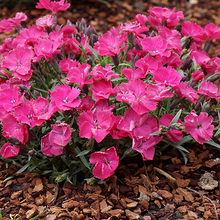Dianthus 'Vivid Bright Lights' is a compact eye catching selection with frilled magenta pink blooms held above tidy blue green foliage. It is valued for its profuse reblooming nature, releasing a sweet clove like fragrance that draws in pollinators from late spring through summer. The finely textured leaves form low mounds that remain attractive even when not in bloom, and its vivid flower color holds well in sun without fading.
Height & Spread: 6 - 8 in x 8 - 12 in
Bloom Time: Late spring to early fall
Light Requirements: Full sun
Soil Preference: Well drained, alkaline to neutral soil
Watering Needs: Low to moderate; avoid overwatering
Deer Resistance: Deer resistant
Native Status
This cultivar is derived from Dianthus species native to Europe and Asia. It is not native to North America but is widely cultivated for ornamental use.
WILDLIFE & INSECTS
Butterflies
- Visited by butterflies such as Painted Ladies, Swallowtails, and Common Buckeyes which are attracted to its bright color and flat open blooms.
Bees
- Provides nectar for honeybees and native solitary bees, especially early in the season when other blooms may be scarce.
Moths
- Night flying moths are drawn to its fragrance and vibrant color contributing to nighttime pollination.
Spacing & Landscape Use
Spacing Recommendations:
- Space 8 - 12 in apart to allow for tidy mounding and airflow around foliage.
Landscape Placement:
- Excellent in rock gardens, border fronts, patio containers, and along walkways where its color and fragrance can be appreciated up close. Works well in mass plantings or tucked into crevices and gravel gardens.
Companion Plants
- Festuca glauca (Blue Fescue) - Adds a cool grassy texture and compact habit that complements the vibrant blooms of Dianthus.
- Phlox subulata (Creeping Phlox) - Forms a colorful mat in early spring that transitions seamlessly into Dianthus flowering season.
- Salvia nemorosa 'Caradonna' (Wood Sage) - Provides vertical contrast and rich purple spikes that draw pollinators in tandem with Dianthus.
- Lavandula angustifolia (English Lavender) - Offers aromatic foliage and upright lavender blooms that echo Dianthus’ tones while attracting bees.
- Coreopsis verticillata 'Zagreb' (Tickseed) - Delivers a fine textured bright yellow counterpart to the magenta hues of Dianthus.



